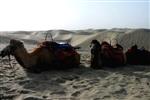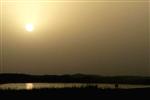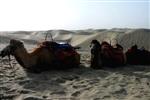- Getting around Lijiang. Dont stay in the Old Towns more than 2 days, there is nothing to do. KRISS Oct 9, 2013 05:46
- 2013 Beijing Temple Fair BENNYLAU Feb 26, 2013 03:29
- Malaysian traveling from KUL - LAX vis Shanghai PVG ZATI_DY Jan 3, 2013 20:15
All Silk Roads Lead to the Taklamakan
- Views: 5313
- |Vote: 0 0
- |Add to Favorites
- |Recommend to Friends
“I’m sorry, I must have heard you wrong” I told the men at the gate in Chinese. “Tell me again, how much will it cost for me and my friends to enter the park?” One of the gate guards repeated himself slowly and with better pronunciation, but the price remained the same.
“Are you kidding me? The price on the ticket doesn’t say that much! What’s the extra charge for?” I was getting a little frustrated.
“The car.”
So it was that I paid for four tickets and a car in order to see the incredible Taklamakan Desert. Since spending quite some time in Xinjiang I have fine-tuned my ability to negotiate, but when you have no bargaining chips to begin with you’re pretty much sunk. We had just driven 2 hours from Kashgar and the men at the gate knew that we wouldn’t turn back. We were going to see the desert and their gate was the only way we knew how to get in. I actually considered having our driver park the car outside the gate and walk through, and although that sounds like a good idea I doubt our driver would have been too happy with us.
Although there are many different places from which to enter the huge Taklamakan Desert, our point of entry was from Kashgar. Travel agents in the city had told us that there were two places that offered the best desert experience, each with their own unique qualities. The best option was nearly four hours away by car but was the least traveled and offered the best “picture-perfect” views. The second option, the one we eventually took, was more ‘touristy’ but was only two hours each way. Had we not been short on time we most certainly would have chosen the first, but regardless both locations still allow you to experience the desert and that’s all we really wanted to do.
After paying our dues and saying goodbye to the lovely gate guards, we ventured into the Taklamakan oasis. At first it didn’t seem like we were even near a desert. Tall trees lined the street on each side and a small lake we later learned was named “Drakul Lake” loomed ahead of us. It was obvious that during the summer months this place functioned more as a resort for Chinese people than a destination for foreign tourist. A small hotel was situated on the left and many Uyghur restaurants, which for the time being were completely deserted, were probably filled with guests during the warm months. The “beach” leading to the lake was covered with sand, paddle boats for rent, games, and umbrellas. Just around the corner was a place to rent camels and dune buggies to roam the desert. This place knew we were tourist and they desperately wanted to find any way to get our money.
We decided on the camels. Any trip to the desert would not be complete without a ride or a picture on the camels, right? Unfortunately, the camel owners also know that this is a must for any desert visitor so they tend to take advantage of this knowledge. Just ten minutes after dealing with the guards at the gate, I found myself again fighting to keep from being taken advantage of.
“I’m sorry, but I will not pay 300 RMB per person for one hour on a camel. I’m not stupid. The most I’ll pay is 40” I defiantly told the owner.
“That’s ridiculous! The cost of keeping camels has risen over the past year, so I can’t make any money if I give you that price. 280 is the lowest I’ll go” he answered.
By this time I was fed up with bargaining, so I snapped a bit. “Look around you! How many camels are there here and how many people do you see?” A simple glance would reveal that over 30 camels sat unused nearby and we were the only visitors that he would see all day. “Give me a good price or you won’t be making one single RMB today!”
A few more heated exchanges and fifteen minutes later we finally agreed on a reasonable price – 60 RMB per person – but I still felt like I’d been had and was exhausted from haggling. All of us, my wife and our two friends, boarded our camels and headed into the desert which unbelievably just appeared out of nowhere on the other side of the lake. Like a heavy burden being lifted from my shoulders, the views that the desert provided made me forget about the haggling troubles I had to go through to get here.
Straight ahead of my incredibly slow-moving camel were sand dunes that seemed to stretch endlessly under the pale blue sky. I knew deserts had to start somewhere, but the stark contrast between the desert and the tree-lined lake was absolutely fascinating. We meandered through the dunes led by our friendly camel guide until we reached the final stopping point. Here we were let off the camels to explore the dunes on our own for a bit, something we were more than eager to do. We took pictures of each other, pictures with the camels, pictures of the desert, pictures of us running in the desert…you name it, we took it.
The word Takla Makan literally means “to go in and never come out” and the lack of water within this desert is probably the reason why. This desert is the second largest shifting sand desert in the world and the biggest in China, covering somewhere near 300,000 square kilometers. It’s location on the southern part of Xinjiang, China meant that the early Silk Road travelers had to cross it on its northern and southern edges to avoid the arid wasteland. Presently there is actually a cross-desert highway that has been built from Hotan to Luntai stretching for 552 kilometers, the longest of its kind. The most interesting part of this desert is that unlike most deserts that have a reputation for being terribly hot, the Taklamakan has the characteristics of a cold desert with temperatures reaching well below zero during the wintertime.
It wasn’t quite as hot or cold as I was expecting. I’m sure that traveling during the dead of summer or winter could make this trip unbearable, but I guess that’s the beauty of having a lake nearby. The sun was bright which required us to wear sunglasses and hats, but the cool October breeze made the desert visit pleasant.
Everything was beautiful and perfect, until…
“Ok. Time to go back! Please mount your camels” the guide said.
The time had been short but we had done what we wanted to do. Even still, the guide noticed our apprehension and made a nice suggestion. “How about we take a short detour over there on the way back” he said, pointing to some more beautiful looking sand dunes to the side along the lake.
“Oh yea! Good idea.”
As we made our way back we reached a fork in the road, one side leading back to “base” and the other our detour. To our surprise, the guide stopped.
“To take this detour it will cost you another 100 RMB” he said without flinching. This was one of the oldest tricks in the book and I was mad at myself for not recognizing it earlier.
“Sorry, buddy. You’re not going to get any more money out of us and you have now lost any ounce of respect I might have had for you.” Unbelievably our guide was a bit upset that we wouldn’t accept his offer, hinting at the fact that most groups he took were more than willing to fork out the extra cash. He grudgingly delivered us back to the lake where we began this journey into the desert.
The rest of our time was spent sitting alongside the lake, talking and waiting for the sun to set over the desert. Dinner would be light, and yet in this little resort would cost a small fortune. Staying the night was an option, but we were ready to get back to our comfortable beds in Kashgar. A day was more than enough to enjoy the beauty of the desert, and we needed someplace to get the sand out of our shoes.
Travel Tips and Costs:
1) Don’t go to the resort if you can avoid it! If this review isn’t enough of an indication, I’ll go right out and say that while we loved the desert we were sorely disappointed with the actual resort. There isn’t an English name that I found, but it lies two hours southeast of Kashgar.
2) Bring your own water and sunglasses.
3) Be prepared to bargain for your soul. These people are ruthless!
Costs:
Transportation: You’ll need to rent a car or go with a tour company to get to the desert, so expect to pay somewhere around 50 RMB per person or 200 RMB for a car for a one-day trip.
Entrance: 20 RMB per person as well as a car tax, apparently
Camels: A good price is around 50 RMB for an hour, but don’t be surprised if you have to pay 80-100 RMB. Also, keep an eye on your watch to make sure they honor the hour they promised you.
Dune Buggies: You can rent a dune buggy for about 180 RMB for an hour and it requires a copy of your driver’s license (foreign or domestic). You can stuff up to four people inside and you’ll drive it yourself. We avoided this option because you don’t actually drive on the dunes, you drive on marked paths around the dunes. Not cool.
Everything else: Food, games, boats, hotels…they all have a price and all of it is usually negotiable. But why do all that? Just bring your own picnic lunch and sit out by the lake!









 Copyright © 1998-2026 All rights reserved.
Copyright © 1998-2026 All rights reserved.